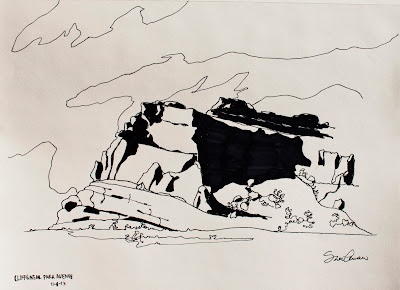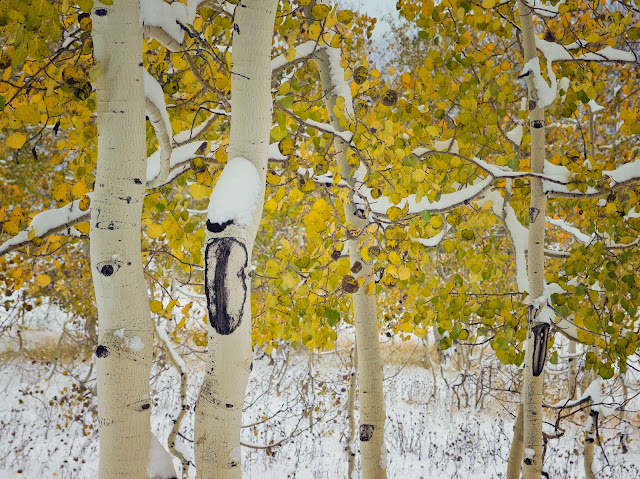I spent the night down off the
Hole-in-the-Rock road. This hyphen-heavy road was created by some industrious
Mormons who got stuck in Glen Canyon during the San-Juan expedition. Surrounded
on all sides by 1200 foot cliffs with the canyon turning south-west, rather
than turning back in search of a better route, they found a small crack in the
cliff and blasted it into a roadway that would take them all the way to the
rim. They then built a road through what is today the Grand Staircase-Escalante
National Monument which is now managed by the Bureau of Land Management. As
would be expected they very shortly found a better way through the area and the
road fell into disrepair. It was abandoned until that second great rush into
Utah, the Uranium boom. The Hoskaninni Mining Company revived the road on their
way to look for Uranium in the hills of the Grand Staircase. Today, it is a
well maintained dirt road that leads to a lot of the most popular destinations
in the national monument, Coyote Gulch, Peekaboo Wash, and The Devils Garden,
where I was staying.

In the morning, I got up and made
a breakfast and did a little bit of writing until the sun warmed me up enough
that I was willing to get out of my sleeping bag. By then other cars were
coming in and hikers were getting out into the labyrinth of bulbous rocks and
arches in the Devil’s Garden. As I was getting my boots on, a couple walked by
and I heard them murmur something about “North Carolina plates” as they saw my
car. I called out excitedly, asking if they were from North Carolina too. Their
faces lit up and they walked over. I hadn’t seen anyone from North Carolina in
a long time and I was excited to hear where they were from; Kinston perhaps, or
maybe Winston-Salem, maybe even Pinetops! “We’re from Charlotte!”… “Oh…” I
tried to hide my disappointment as I told them I was from Raleigh. Not that
there’s anything wrong with Charlotte, it’s just a soulless banking city that
likes to whine about not being the state capitol just because it’s a bit bigger
than Raleigh. You need more than a football team, some sky scrapers and NASCAR…
However, I put my prejudices aside and hike with them for a while. They stopped
by the bathroom on the way out and discovered, as I had earlier but failed to
warn them, that there was no toilet paper. A bit mystified as to how they both
made this discovery after sitting down when they went to the bathroom together,
I say, “Well the toilets are
officially closed during the shutdown, but at least they didn’t lock them”. The
man replies “Of course, they don’t bother to refill the toilet paper but
they’re more than happy to stand at the gates to the parks and tell us we’re
not wanted…” I knew there was a reason I didn’t like people from Charlotte…the
same attitude that gets them up in arms about their Queen City status.
Alright, First of all, the Bureau
of Land Management and the National Park Service are two different agencies.
The BLM land is too dispersed to be closed off during the shutdown; we’re just
on our own for the little conveniences like toilet paper that they usually
provide for free(…the horror). Second, there’s nothing the rangers in the
National Parks want more than to open the gates to the parks and let tourists
back in. For one, it would mean they were getting paid again; most importantly
though, they actually enjoy their
work and want to see people coming in
and hiking the trails and attending geology lectures and camping! Now you may have
heard of some rangers offering to work for free to reopen the parks and being
denied. To keep the park closed it requires a crew of law enforcement rangers
to man the entrance and patrol the park. To reopen the park you’d need interp,
maintenance, fees, campground hosts, cashiers, hotel staff and resource
management all to agree to work for free; not just the one guy who told the
paper he’d be willing to. Besides, in my personal opinion the government
shouldn’t be allowed to have its cake and eat it too. As well intentioned as
these potential volunteers are, the government would gladly take advantage of
that sentiment to remove the heat from their feet and continue their impasse
indefinitely while employees at popular government agencies worked for free.
Workers in the parks deserve to be paid and
not have their livelihood used as a tool to squeeze votes out of politicians.
Now I gave the poor man from
Charlotte the first half of this rant and then resumed more pleasant
conversation about how I had ended up out here. He back-peddled a bit and said
he wasn’t really angry at the park service, just the government and I said that
was something we could agree on and we went our separate ways.

The trail disappears and smooth,
red slick-rock hills roll down to the scrubby fields below. A small canyon
divides the two halves of the red rock and after finding my way to the floor I
follow it back to the garden. Along the way, a saddle shaped pocket in the canyon
wall is visible from the floor complete with saddle horn projecting out over
the gap. I climb up into the saddle, the rocks appear smooth but the striations
in the layers of sandstone give good grip and I can walk up the steep walls. I
climb out to the saddle horn and lay down in a depression with a dent just big
enough for my hips, making a comfortable spot to take a quick nap. As I lay
there I tap on the sandstone with my fist. Some sections sound with a solid
dull thud while other spots transmit the vibration of the impact through the
surrounding thin sheet of stone, sounding hollow. I pick at one of these spots
and find a seam where an outer shell of sandstone has separated from the
boulder underneath.

I climb down from the horn into
the saddle again and follow the slope to a spout that lets out about 6 feet
from the canyon floor. The ground on the floor is gently packed dirt and I
decide to jump. My legs, still sore from climbing to get to the canyon
yesterday, betray me though and crumple under me as I land sending me rolling
down into the middle of the dry streambed.
I cross the gap and climb up into
the garden once again and up then up to the top of the sandstone mushrooms.
They’re close enough together that the spans between the tops can be jumped and
I make my way over to the area above metate arch. The flat top of the arch
extends out and ends in a rounded bulge, looking like a kind of modern coffee
table from above. I had been planning to visit other trails today but it’s time
to slow down and just enjoy being where I am. I sit down across from the arch
and enjoy the cold breeze on my face and the warm sun on my back.

















































